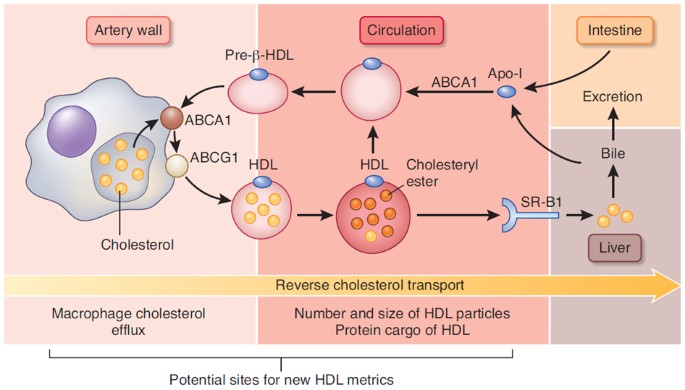
A new era for quantifying hdl and cardiovascular risk?
- Select a language for the TTS:
- UK English Female
- UK English Male
- US English Female
- US English Male
- Australian Female
- Australian Male
- Language selected: (auto detect) - EN
Play all audios:
Access through your institution Buy or subscribe High levels of low-density lipoprotein (LDL) promote atherosclerosis by delivering cholesterol in an unregulated manner to artery-wall
macrophages, a key step in atherosclerotic vascular disease. In contrast, clinical and epidemiological studies show a robust, inverse association of high-density lipoprotein (HDL) levels
with cardiovascular disease risk. HDL's cardioprotective effects are mediated in part by its ability to remove cholesterol from macrophages. Mice with genetically engineered
deficiencies in proteins involved in HDL metabolism provide compelling evidence that HDL is a key modulator of atherosclerosis in hypercholesterolemic models. These observations have
triggered intense interest in targeting HDL for therapeutic intervention. HDL can be quantified by blood concentrations of its major protein component, apoA-I, and by its content of
cholesterol. Some studies suggest that low concentrations of apoA-I associate more strongly with cardiovascular disease risk than do HDL cholesterol (HDL-C) levels. Virtually all clinical
studies have used HDL-C as a metric for quantifying HDL's cardioprotective effects. However, recent evidence has raised doubts about the hypotheses that elevating HDL-C is necessarily
therapeutic. For example, genetic variations that associate with altered HDL-C do not strongly associate with altered cardiovascular disease risk1. Also, trials of two drugs that elevate
HDL-C levels—niacin and the cholesteryl ester transfer protein (CETP) inhibitor dalceptrapib—were terminated prematurely because of an apparent lack of clinical benefit in subjects with
established cardiovascular disease1. This is a preview of subscription content, access via your institution RELEVANT ARTICLES Open Access articles citing this article. * CHOLESTEROL IS
INEFFICIENTLY CONVERTED TO CHOLESTERYL ESTERS IN THE BLOOD OF CARDIOVASCULAR DISEASE PATIENTS * Mathias J. Gerl * , Winchil L. C. Vaz * … Otilia V. Vieira _Scientific Reports_ Open Access
03 October 2018 * THE EFFECT OF ANDROGEN EXCESS ON MATERNAL METABOLISM, PLACENTAL FUNCTION AND FETAL GROWTH IN OBESE DAMS * Romina Fornes * , Manuel Maliqueo * … Elisabet Stener-Victorin
_Scientific Reports_ Open Access 14 August 2017 * LIPOPROTEIN HYDROPHOBIC CORE LIPIDS ARE PARTIALLY EXTRUDED TO SURFACE IN SMALLER HDL: “HERNIATED” HDL, A COMMON FEATURE IN DIABETES * Núria
Amigó * , Roger Mallol * … Xavier Correig _Scientific Reports_ Open Access 18 January 2016 ACCESS OPTIONS Access through your institution Subscribe to this journal Receive 12 print issues
and online access $209.00 per year only $17.42 per issue Learn more Buy this article * Purchase on SpringerLink * Instant access to full article PDF Buy now Prices may be subject to local
taxes which are calculated during checkout ADDITIONAL ACCESS OPTIONS: * Log in * Learn about institutional subscriptions * Read our FAQs * Contact customer support REFERENCES * Rader, D.R.
& Tall, A.R. _Nat. Med._ 18, 1344–1346 (2012). Article CAS Google Scholar * Tall, A.R., Yvan-Charvet, L., Terasaka, N., Pagler, T. & Wang, N. _Cell Metab._ 7, 365–375 (2008).
Article CAS Google Scholar * Bérard, A.M. et al. _Nat. Med._ 3, 744–749 (1997). Article Google Scholar * Trigatti, B. et al. _Proc. Natl. Acad. Sci. USA_ 96, 9322–9327 (1999). Article
CAS Google Scholar * de la Llera-Moya, M. et al. _Arterioscler. Thromb. Vasc. Biol._ 30, 796–801 (2010). Article CAS Google Scholar * Khera, A.V. et al. _N. Engl. J. Med._ 364, 127–135
(2011). Article CAS Google Scholar * Rosenson, R.S. et al. _Clin. Chem._ 57, 392–410 (2001). Article Google Scholar * Vaisar, T. et al. _J. Clin. Invest._ 117, 746–756 (2007). Article
CAS Google Scholar * Mackey, R.H. et al. _J. Am. Coll. Cardiol._ 60, 508–516 (2012). Article CAS Google Scholar * Green, P.S. et al. _Circulation_ 118, 1259–1267 (2008). Article CAS
Google Scholar Download references AUTHOR INFORMATION AUTHORS AND AFFILIATIONS * Jay W. Heinecke is in the Department of Medicine, University of Washington, Seattle, Washington, USA., Jay W
Heinecke Authors * Jay W Heinecke View author publications You can also search for this author inPubMed Google Scholar CORRESPONDING AUTHOR Correspondence to Jay W Heinecke. ETHICS
DECLARATIONS COMPETING INTERESTS J.W.H. receives research support from Merck, GlaxoSmithKline and Bristol-Myers Squibb. RIGHTS AND PERMISSIONS Reprints and permissions ABOUT THIS ARTICLE
CITE THIS ARTICLE Heinecke, J. A new era for quantifying HDL and cardiovascular risk?. _Nat Med_ 18, 1346–1347 (2012). https://doi.org/10.1038/nm.2930 Download citation * Published: 07
September 2012 * Issue Date: September 2012 * DOI: https://doi.org/10.1038/nm.2930 SHARE THIS ARTICLE Anyone you share the following link with will be able to read this content: Get
shareable link Sorry, a shareable link is not currently available for this article. Copy to clipboard Provided by the Springer Nature SharedIt content-sharing initiative